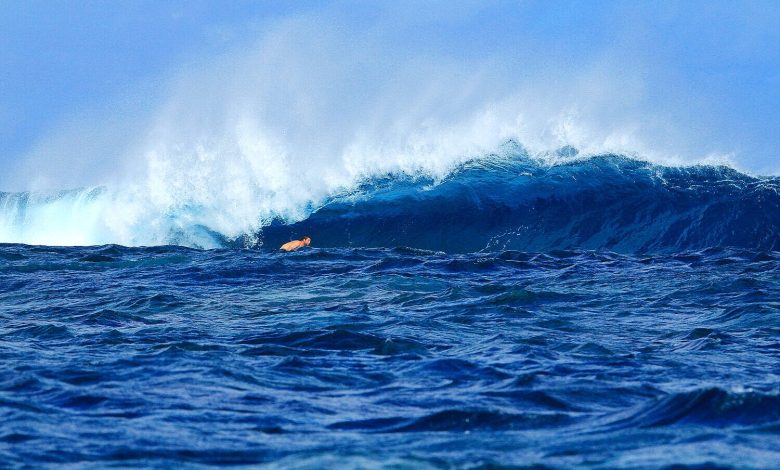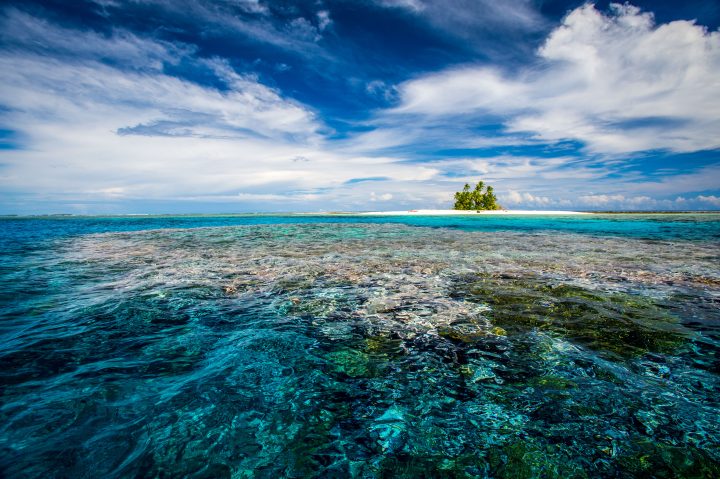Coral-Clinging and Climate-Changing in the Deep Blue Womb of Polynesia – Tuvalu
South Pacific ????

Long voluptuous late-day shadows. Sputtery motorbikes, cackly kids, idle unamused adults. There is no hurry. Nothing pressing, nowhere to go. Unless they work in a fusi (shop) or get handicrafty, most Tuvaluans do little because there is little to do.
And yet Funafuti Atoll’s main coral road is abustle. We seek refreshment. In a tight black “Beautiful Since 1992” T-shirt, her hair yanked into a bulbous brown bun, Katalaina is the young doe-eyed clerk at Tefota Mini-Mart. Outside, crude art on the red-and-blue shipping container hawks Tefota Liquor Express and its “amazing beer garden.” A green taro leaf-shaped arrow points the way. But the amazing place isn’t open.
Illegally (so she claims), Katalaina sells me a sixer of Victoria Bitter. Daniel, Nico, and I each crack a can. Then another. Seeing this, Katalaina demands we file into the shaded area behind her fusi.

“Might we get arrested?” I ask.
She laughs. “Probably. The police here don’t have much to do except arrest guys who are fighting or are drunk on the street.”
“These are our first beers today. We’re not drunk.”
“Not yet,” Nico says beneath his sly Canuck smirk.
“Did you guys come to see our islands sinking?” she asks.
“Tuvalu is sinking?” I ask.
“Isn’t that why you came?”

“No,” Daniel interjects softly. He’s reading the label on his beer can. “We’ve come to surf.”
“Surf?” Her brown eyes pop like beautiful flowers yawning into the hot orange shimmer of late Sun. “You mean standing on the waves?” She laughs again, mockingly. “I have seen some guy with surfing gears and heard about surfing in Tuvalu but have not actually seen anybody surfing.”
“You won’t,” I say, “unless you get into a boat with us and go to the other side of your huge lagoon. May we please buy another six-pack?”
Tuvalu is one of Earth’s least-visited countries, pre-Covid receiving perhaps 2,000 tourists per year. It is Earth’s fourth-smallest country—nine atolls totalling less than 10 square miles of land for 11,000 people, all of them fanned across 500,000 square miles of brilliant blue. Katalaina says foreigners come either because “they want to see this place before it sinks into the sea” or because they are mere “country collectors”—people who aim to visit all 197 of Earth’s terrestrial nations. Other visitors are aid workers, business consultants, and government hacks. People rarely choose to visit Tuvalu for a holiday, she claims. Why would they? Resource-poor atolls have scant world value per what ex-Prime Minister Toaripi Lauti once declared, that “all Tuvalu has to offer is Sun and a piece of the Pacific.”

Katalaina’s “amazing beer garden” is a pair of scuffed green tables on gravel under a rusty metal roof, all of it surrounded by a chain-link fence topped with concertina wire. There’s a warped plywood bar below a big flat-screen showing an episode of Glee.
Katalaina looks weary. Since standing behind the bar, her once-bright demeanor has dimmed. She glares at us. We are drinking more beer. Blathering. Intoxicating. Not surfing. Way over there, on the opposite rib of her galactic lagoon, the waves are bad. The swell is too small. Rivers of wind. Always too windy. The tide is too low. Always too low.
“We missed it by a few thousand years,” Daniel says after another deep beer burp.
An intelligent observer of life and waves, his face is flexed, his mind mossy. His brown forearms rest on the table. Glee has lost him. He’s staring at his green can. He’s thinking about the weird left-hander he surfed yesterday.
For every surfer in the world who isn’t here, Daniel, can you please describe this wave?
“Okay.” Clears his throat. “Three barrels and three turns on a quick, punchy, warmwater left only to be discombobulated in the end by wind chop and coral heads. When the reef wasn’t quite as high, we could’ve surfed that spot on all tides. It could’ve been one of the funnest lefts ever when Funafuti was still a sinking volcano.”

Sinking. That word again. Twelve thousand feet from the ocean floor, Funafuti is the coralline rim of an oblique conical submarine volcano. In the 1990s Tuvaluan leaders assured the world that, due to climate change, within a few decades Tuvalu would vanish—an actual Atlantis. In 2001 I bought a heartbreakingly gorgeous Lonely Planet photo book titled Time & Tide that dealt exclusively with climate change and its future ills for the atolls. In 2002 Tuvaluan leaders threatened to sue the First World for its high emissions of carbon dioxide, methane, chlorofluorocarbons, and nitrous oxide that in the past 60 or so years combined to heat Earth’s atmosphere (the “greenhouse effect”) which then caused poles to melt and oceans to rise, which presumably will swamp low landforms like atolls. (Since the second Industrial Revolution, anthropogenic activity has increased Earth’s atmospheric carbon dioxide concentration by more than a third.) Among media coverage worldwide, Outside’s Mark Levine, in a long 2002 piece titled “Tuvalu Toodle-oo,” pointedly blamed his own readers: “The serene South Pacific archipelago of Tuvalu wants the world to know it will soon be the first nation to sink beneath the rising waters of global warming—an early warning of biblical inundations to come. And guess what? It’s your fault.”
Today there are scientists who feel Tuvalu’s leaders are opportunists exploiting a possibly fact-skewed reality and insisting that their people flee Tuvalu for, ironically, the West’s pollutive ways. Prime Minister Saufatu Sapo’aga reaffirmed Levine’s premise, telling the United Nations that carbon discharge from the world’s superpowers was “a slow and insidious form of terrorism against us.”
Certainly no climate change-denier, Kennedy Warne is the co-founder of New Zealand Geographic, where he published “Tuvalu Rising.” Based on comprehensive scientific input, this March 2018 piece shocked me and debunked Sapo’aga and Levine and the “dozens, if not hundreds, of similar stories, broadcasts, films, and books (that) have appeared since then, almost all with doom-laden titles and headlines”:

Perhaps the most damaging effect of the drowning-islands rhetoric is that it has conditioned atoll islanders to think of themselves as climate victims doomed to lose their islands to rising seas, and, in the worst-case scenario, to become stateless refugees. Recognition that their land will not disappear gives island dwellers hope and incentive to draw on their traditional traits of resilience, adaptability, and skill in continuing to inhabit the islands they call home. It should also motivate governments and aid agencies to focus less on engineering interventions and more on a strategic approach to multi-atoll development.
Warne’s words were buttressed by information in February 2018’s edition of Nature Communications, a peer-reviewed bimonthly scientific journal. At the University of Auckland, with colleagues in Fiji and Australia, coastal geomorphologists Susan Owen, Paul Kench, and Murray Ford optimistically asserted that Tuvalu was perhaps not so ill-fated. “The common narrative is that these atolls are ‘sinking,’” Ford told me by email. “They are not sinking. As sea levels rise, the atolls may drown if they sit there passively as if they were in a bathtub. But they’re not. There is more land in Tuvalu now than there was in the mid-20th century.”
Citing data gleaned since 1971, when such surveys began, Warne noted the South Pacific’s rise annually averaged 3.90±0.4 millimeters, twice the global mean, likely due to Antarctic adjacency. However, despite an amassed sea-level rise of about 15 centimeters (six inches), specific analyses of Tuvalu revealed the place wasn’t sinking nor shrinking. Perhaps counterintuitively to us, Tuvalu was growing—by 183 acres, to be exact. “The islands are able to increase in size because they are composed of the broken-up remains of coral and other organisms that secrete calcium carbonate (e.g. shells, foraminifera),” Kench told me, also by email. “As long as the reef is producing sediment, waves can transport it to an island. In the case of Tuvalu, major storm events rip up coral, etc., and dump it on the atolls.”
With data from aerial photos compiled in that four-decade timeframe, the UofA trio measured the shorelines across 19,403 transects of Tuvalu’s mostly-undeveloped islands and islets. (“Undeveloped” meant lack of concrete. Natural oceanic landforms were naturally dynamic, over time shifting with natural winds, currents, and swells. And, yes, rises in sea level.) All of Tuvalu’s landforms showed slight change. Most had grown; one had more than doubled in size.
“The hard limestone structure built by corals over thousands to millions of years doesn’t really change over these short timeframes,” Ford said. “On top of that foundation is the living reef which always wants to grow to sea level—lowest tide level, actually—so it may keep up with sea-level rise providing that the reef remains healthy, which remains a significant unknown. Atop it all are the atolls. These have been built by the breakdown of the reef and the reef organisms in the last 3,000 years.”

Shrinkage was most pronounced on the sand cays along Tuvalu’s leeward coast which on Funafuti is where we found surf. One cay had recently vanished. Expansion was greatest in the medium-to-large-sized islets along the atolls’ windward edge where storm surges, high tides, and constant wave action had heaved sediment onto reef platforms. This, the scientists believed, has and will offset erosion perhaps indefinitely. “In the coming decades we expect there to be a small increase in water depths across the reef,” Kench said. “This will increase shoreline wave height, which can deliver material to island surfaces. We expect islands to change in size and position on reef surfaces and to also maintain their size due to sediment delivery. Problems may arise if reefs start to become less productive and new sediment is not generated.”
“There may be a difference in the water depth over the reef in the next 20 years,” Ford said. “Depending on the particular scenario we’re looking at, a 20-centimeter-higher sea level (is possible by) 2040. A healthy reef may respond by growing vertically, potentially offsetting some of this sea-level rise. If the reef dies, there’s unlikely to be any vertical reef growth to offset sea-level rise. In fact, some of the reef structure may be broken down.”
Might this improve the waves? Should surfers care?
Are you going to Tuvalu?
In September 2019, just after Funafuti’s election, Karima Bennouneis, the non-surfing UN Special Rapporteur in the field of cultural rights, visited Tuvalu “to learn how Tuvalu’s new government would combat discrimination. I will also assess policies designed to mitigate the grave threat climate change poses to the culture and cultural heritage of Tuvalu, and how culture is and can be used to respond to the existential challenges resulting from climate change.”
Overall climate change is most certainly real, yes, as real as Tuvalu’s rickety reefs. Only a fool would deny either. It’s all in our faces. Back here on Funafuti’s windward side, Nico’s is Sun-red. He’s just downed another beer. Nibbling her fingernails, Katalaina watches us. Perhaps she is pondering climate change and is hoping we too will disappear.

Another six-pack?
Yesterday Nico duckdove onto a large coral head, fracturing the pointed nose of his skinny thruster. He was pushed back then dry-docked, where he stood bravely before a loud wall of white. An irksome session with few moments of zen. Rogue side-wedges from the north were a hazard and hassle.
My right palm is cold and wet from another can of Victoria Bitter. My mouth tastes metallic. VB reminds me of Pabst Blue Ribbon. I begin to think VB is not great. Nico likes it. I ask him to recap his Tuvalu surf experience.

“Bit of a mindfuck. But with deeper reefs and better swell exposure, this place might be heaven.”
Heaven?
We leave tomorrow.
Plucked from Rainbownesia, available globally via Amazon.
By Michael H. Kew


